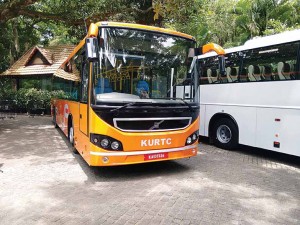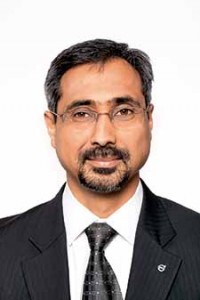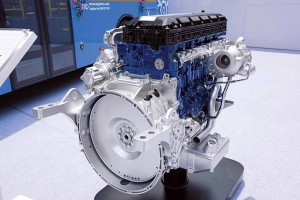Volvo Buses India is leveraging technology and knowledge to increase its market reach.
Story by: Bhushan Mhapralkar
Present in India since 2001 in the premium bus and coach segment, Volvo Buses India has delivered 100 BSIV emission compliant buses since the standards were implemented on April 01, 2017. Complementing the 1000 BSIV buses the company has delivered from before the BSIV emission regulations were enforcement across the country, the Volvo 9400 range of multi-axle coaches is claimed to be among the first BSIV emission compliant buses to be supplied to Indian customers. The development follows a localisation announcement by Volvo Buses at Busworld India last year. The company announced the deployment of BSIV compliant 330 hp (Volvo D8C) 8-litre six-cylinder engine in its 12 m B8R inter-city coach. The D8C engine is made at the Volvo Eicher PowerTrain (VEPT) joint venture engine plant at Pithampur. The 9400 multi-axle coach, at the other end, is powered by a 370 hp 11-litre six-cylinder engine. Finding use with institutional and private operators for long distance travel, typically in the range of 600 to 1000 kms, the driveline and powertrain of the Volvo 9400 range are designed to last the lifecycle of the bus. This is typically 10 lakh kilometres. Apart from long service intervals, the key aggregates of the Volvo 9400 range are said to significantly lower the running costs and NVH levels. Offering better travel comfort and lower driver fatigue, which elevates safety, the Volvo 9400 range features ABS, Electronic Braking System (EBS), disc brakes and hill-start assist. It also employs the I-Shift automated manual transmission.
Leveraging technology and knowledge
Displaying BSIV emission compliant multi-axle 9400 coach, and a 12 m low-floor hybrid city bus at the Prawaas 2017 exhibition held at Navi Mumbai, Volvo Buses India aptly hinted at a strategy to leverage technology and knowledge to increase the market reach. Speaking on the sidelines of the expo, Akash Passey, Senior Vice President, Business Region International, Volvo Bus Corporation, expressed that they have been talking of this (an bus operator event) even as the bus story in India unfolded. “For someone who has been associated with the bus industry for the last 25 years, it is good to see operators working in the same direction, and towards the improvement of the industry,” mentioned Passey. He described Prawaas 2017 fair, organised by the Bus Operators Confederation of India (BOCI), as momentous.
Defining GST as a pathbreaking development, Passey stressed upon rising unity among private operators in India as a sign of maturity. It is important to Volvo from a business point, he quipped. Opining that for a country that provides long distance and city bus services this is a game changer, Passey termed the Indian bus market as a combination of institutional bodies supported by the government, and small private operators. He drew a comparison with other markets of the world where the line separating the institutional operators and private operators is thin. “Every country has its own processes, procedures and needs. The public transport system works well when the government creates the right infrastructure and frames the right policies.” Passey explained. Opining that the success of an operator is beyond his status as a private or an institutional operator, Passey expressed that successful operators are operating across continents. He cited an example of a Volvo operator in Australia. The same operator runs buses in Singapore, London, Brazil, and Chile. With governments focussing on creating regulatory conditions that are conducive to business, and putting their demands clearly, contracts, said Passey, are given for five, seven, 10, or even 15 years.
Global trend
Stating that attention is not on cost per km, but on the number of footfalls, Passey said that stress is on 90 per cent occupancy in many parts of the world. “City bus operators are running school bus loads during non-peak hours,” he highlighted. Pointing at LTE (land transport body), Singapore, Passey mentioned that there is a clear vision about what has to be achieved in the next 25 years, and in the next 50 years. There is an implementation plan in place, he said. Five years ago, the LTE opened more routes to global operators. and increased the number of operators from two to five. “In Hong Kong,” said Passey, “the government is focusing on creating a regulatory path.” Public transport there is run through 4000 buses, he informed.
Considered to be one of the most challenging bus operations with little road space and high population, every bus at Hong Kong is a double decker. A private company is running the service for the last 15 years. Drawing a comparison with Singapore and Hong Kong, Passey mentioned, “Unlike these countries and regions, India has a fragmented operator markup, which gives rise to unique challenges, and calls upon the need for the operators and the government to work together to achieve a common goal.” Expressing that the success of the governments is also high in such a situation, Passey stressed upon self sustenance, and operators operating not just buses, but also trains and ferries. Not just in one country but across continents. Pointing at the multi-modal nature of operations of many global operators, Passey expressed that the coming together of operators in India will lead to self sustenance. “It is also in-line with the global trends,” he mentioned.
The wanted picture
Pointing at a situation twenty years ago when two operators with businesses 10 m apart would not see eye-to-eye, Akash averred that his wanted picture was to see an Indian operator run operations in other parts of the world. “This is irrespective of him being an institutional body or a private body,” he said. Stressing upon the need to arrive at this picture, Akash touched upon the shift in thinking of government and operators over the last few years in India. “It should not be forgotten that India is the second largest bus market after China,” he informed. India and China together account for 60 to 70 per cent of the global bus volume. In terms of population, India and China account for 2.5 to 2.6 billion people out of the seven billion global population. With every fifth person in the world a Chinese, and every sixth person in the world an Indian, China and India are logically the largest and the second largest bus markets in the world. It is in these countries that the need to move people is. Stated Passey, that he clearly sees India as the second largest bus market in the world with enormous potential. “The segment we are in, did not exist ten or twelve years back. Today it is in a small way playing an important role,” he expressed. Terming the rise in local content in Volvo buses as overdue, Passey linked it with the need to efficiently move people from one place to another. Pointing at the D8C engine finding use in Volvo buses the world over, Passey expressed that he looks at demonetisation, migration to BSIV emission standards and the implementation of GST as a way of life.
Terming demonetisation, migration to BSIV and GST as long overdue, Passey averred that the industry and the government should work together. Pointing out at the BSVI buses rolling out of the Bangalore facility of Volvo for export to Europe, Passey opined that they are sending BSVI engines from here to all parts of the world for the last three years. Of Volvo Group and Volvo Buses moving up to BSVI, Passey said, that it will be a challenge to do it frugally. He mentioned that their premium positioning will add to the challenge, and technology will have to be leveraged to achieve the goal. “Euro6 takes a lot of technology, and we have it,” said Passey. The export of Euro6 12 m two-axle coaches is proceeding as per the plan. According to Passey, the bus bagged the tittle of ‘Bus of the Year’ in Spain. Spain is one of the two markets (the other is France) that the bus is exported to. With new markets for the bus opening up in Europe, Passey commented, “We are going slow and steady.”
























